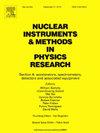Portable distortion free large solid angle coverage detector
IF 1.5
3区 物理与天体物理
Q3 INSTRUMENTS & INSTRUMENTATION
Nuclear Instruments & Methods in Physics Research Section A-accelerators Spectrometers Detectors and Associated Equipment
Pub Date : 2025-03-20
DOI:10.1016/j.nima.2025.170446
引用次数: 0
Abstract
Neutron single crystal diffractometers require large solid angle coverage for optimum performance. This can be achieved by tiling flat detectors in a cylindrical or spherical geometry, but results in large gaps in detector coverage and parallax distortion. The detector edges exhibit degraded resolution, distortion, and gamma rejection. Since the detector edge regions are a significant fraction of the detector active area, they must be removed from the experimental data set, requiring extra beam time to collect enough analysis data. A spherical detector with a continuous surface would effectively address this issue while eliminating most boundary ‘dead’ areas. Here we report on the development of a novel hemispherical shaped neutron detector using seamlessly tiled readout modules to form the desired shape. The heart of the detector is a specially developed curved neutron scintillator coupled to high resolution silicon photomultiplier (SiPM) Anger cameras via custom made fiber optic tapers (FOTs). The detector has been assembled and initial tests have been conducted at the High Flux Isotope Reactor (HFIR) beamlines at Oak Ridge National Laboratory (ORNL). Here, we describe details of the scintillator design, fabrication and characterization, evaluation of individual detector modules, the details of the detector design implementation, and evaluation of the assembled detector at ORNL beamlines.
便携式无失真大立体角覆盖检测器
中子单晶衍射仪需要大的实心角覆盖以获得最佳性能。这可以通过在圆柱形或球形几何中平铺扁平探测器来实现,但会导致探测器覆盖范围和视差失真的大间隙。探测器边缘表现出分辨率下降、失真和伽马抑制。由于探测器边缘区域是探测器活动区域的很大一部分,因此必须从实验数据集中去除它们,这需要额外的光束时间来收集足够的分析数据。具有连续表面的球形探测器将有效地解决这个问题,同时消除大多数边界“死”区。在这里,我们报告了一种新型半球形中子探测器的发展,该探测器使用无缝平铺读出模块来形成所需的形状。探测器的核心是一个特别开发的弯曲中子闪烁体,通过定制的光纤锥(FOTs)与高分辨率硅光电倍增管(SiPM) Anger相机耦合。该探测器已经组装完毕,并在橡树岭国家实验室(ORNL)的高通量同位素反应堆(HFIR)束流线上进行了初步测试。在这里,我们详细描述了闪烁体的设计、制造和表征、单个探测器模块的评估、探测器设计实现的细节,以及在ORNL光束线上组装的探测器的评估。
本文章由计算机程序翻译,如有差异,请以英文原文为准。
求助全文
约1分钟内获得全文
求助全文
来源期刊
CiteScore
3.20
自引率
21.40%
发文量
787
审稿时长
1 months
期刊介绍:
Section A of Nuclear Instruments and Methods in Physics Research publishes papers on design, manufacturing and performance of scientific instruments with an emphasis on large scale facilities. This includes the development of particle accelerators, ion sources, beam transport systems and target arrangements as well as the use of secondary phenomena such as synchrotron radiation and free electron lasers. It also includes all types of instrumentation for the detection and spectrometry of radiations from high energy processes and nuclear decays, as well as instrumentation for experiments at nuclear reactors. Specialized electronics for nuclear and other types of spectrometry as well as computerization of measurements and control systems in this area also find their place in the A section.
Theoretical as well as experimental papers are accepted.

 求助内容:
求助内容: 应助结果提醒方式:
应助结果提醒方式:


